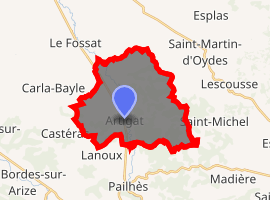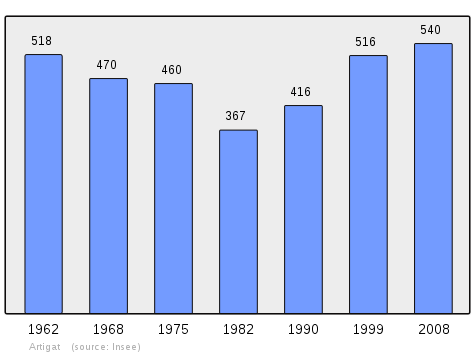Artigat
Artigat is a commune in the Ariège department in the Occitanie region of south-western France.
Artigat | |
|---|---|
Location of Artigat 
| |
 Artigat  Artigat | |
| Coordinates: 43°08′12″N 1°26′26″E | |
| Country | France |
| Region | Occitanie |
| Department | Ariège |
| Arrondissement | Saint-Girons |
| Canton | Arize-Lèze |
| Intercommunality | CC Arize Lèze |
| Government | |
| • Mayor (2014-2020) | François Vanderstraeten |
| Area 1 | 23.9 km2 (9.2 sq mi) |
| Population (2017-01-01)[1] | 564 |
| • Density | 24/km2 (61/sq mi) |
| Time zone | UTC+01:00 (CET) |
| • Summer (DST) | UTC+02:00 (CEST) |
| INSEE/Postal code | 09019 /09130 |
| Elevation | 242–434 m (794–1,424 ft) (avg. 265 m or 869 ft) |
| 1 French Land Register data, which excludes lakes, ponds, glaciers > 1 km2 (0.386 sq mi or 247 acres) and river estuaries. | |
The inhabitants of the commune are known as Artigatois or Artigatoises[2]
Geography
Artigat is located some 10 km west by north-west of Pamiers and 14 km south-west of Saverdun. Access to the commune is by the D919 road from Le Fossat in the north passing through the heart of the commune and the village and continuing south to Pailhès. The D278 road comes from the D26 on the western border of the commune and goes east through the village to join the D36 south-west of Saint-Michel. The D27A also branches from the D919 in the north of the commune and goes east to Saint-Martin-d'Oydes. Apart from the village there are also the hamlets of Bajou in the north, and Les Lanes east of the village. The commune has extensive forests covering about 40% of the land area with the rest farmland.[3]
The Lèze River flows through the commune from south to north gathering several tributaries including the Ruisseau de Laurens with its many tributaries.[3]
Neighbouring communes and villages[3]
History
Until the French Revolution, the Parish of Artigat (with Bajou), as with those of Pailhès, Lanoux, Castéras, Gabre, Aigues-Juntes, Montégut-Plantaurel, Cazeaux, Artix, Saint-Bauzeil, Benagues, Saint-Victor-Rouzaud, Madière, Saint-Michel, Lescousse, Saint-Martin-d'Oydes, and Esplas formed an enclave of Languedoc. They all depended on the Episcopal Diocese of Rieux and the civil diocese of Toulouse while neighbouring communes were part of the County of Foix. See the Cassini Map.[4]
The Parish of Artigat (shown as Arugat on the Cassini Map) was certainly the most important parish of this Languedoc enclave. The famous case of Martin Guerre took place in Artigat.
There was a flood in the autumn of 2006 in Artigat whereupon moat were built in the village.
Administration
List of Successive Mayors[5]
| From | To | Name | Party | Position |
|---|---|---|---|---|
| 1995 | 2014 | Patrick Cauhope | ||
| 2014 | 2020 | François Vanderstraeten |
(Not all data is known)
Demography
In 2010 the commune had 566 inhabitants. The evolution of the number of inhabitants is known from the population censuses conducted in the commune since 1793. From the 21st century, a census of communes with fewer than 10,000 inhabitants is held every five years, unlike larger towns that have a sample survey every year.[Note 1]
| 1793 | 1800 | 1806 | 1821 | 1831 | 1836 | 1841 | 1846 | 1851 |
|---|---|---|---|---|---|---|---|---|
| 932 | 909 | 980 | 1,027 | 1,204 | 1,218 | 1,218 | 1,248 | 1,239 |
| 1856 | 1861 | 1866 | 1872 | 1876 | 1881 | 1886 | 1891 | 1896 |
|---|---|---|---|---|---|---|---|---|
| 1,258 | 1,300 | 1,277 | 1,281 | 1,227 | 1,112 | 1,023 | 1,055 | 1,006 |
| 1901 | 1906 | 1911 | 1921 | 1926 | 1931 | 1936 | 1946 | 1954 |
|---|---|---|---|---|---|---|---|---|
| 962 | 930 | 904 | 813 | 822 | 792 | 701 | 665 | 626 |
| 1962 | 1968 | 1975 | 1982 | 1990 | 1999 | 2006 | 2010 | - |
|---|---|---|---|---|---|---|---|---|
| 518 | 470 | 460 | 367 | 416 | 516 | 524 | 566 | - |

Notable people linked to the commune
- Martin Guerre (famous affair of the 16th century which took place in Artigat).
- Claude Bergeaud (1960-), French basketball trainer was born in Artigat.
See also
Notes and references
Notes
- At the beginning of the 21st century, the methods of identification have been modified by Law No. 2002-276 of 27 February 2002 , the so-called "law of local democracy" and in particular Title V "census operations" allows, after a transitional period running from 2004 to 2008, the annual publication of the legal population of the different French administrative districts. For communes with a population greater than 10,000 inhabitants, a sample survey is conducted annually, the entire territory of these communes is taken into account at the end of the period of five years. The first "legal population" after 1999 under this new law came into force on 1 January 2009 and was based on the census of 2006.
References
- "Populations légales 2017". INSEE. Retrieved 6 January 2020.
- Inhabitants of Ariège (in French)
- Google Maps
- Cassini Map - Arugat (in French)
- List of Mayors of France (in French)
| Wikimedia Commons has media related to Artigat. |